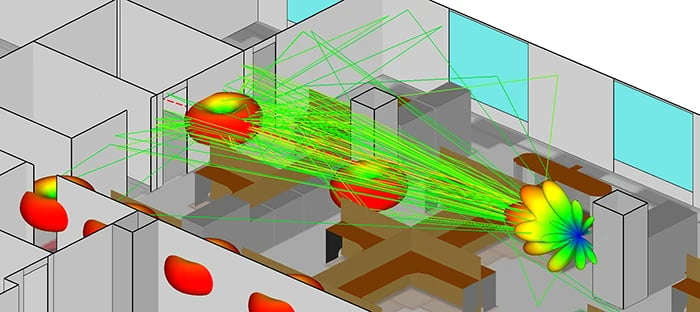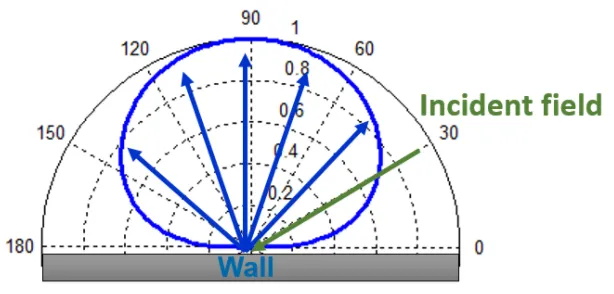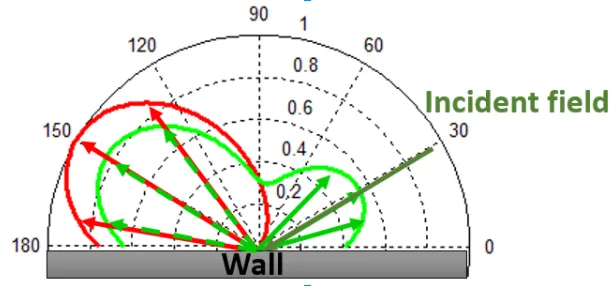- Products & Solutions
- Wireless InSite
- Diffuse Scattering
Diffuse Scattering
Wireless InSite simulates the detailed multipath of large numbers of MIMO channels while overcoming the increased level of computations required for traditional ray tracing methods.

As 5G technology forces expansion into the millimeter wave spectrum, the diffuse scattering model further increases precision by revealing how paths interact with a variety of surfaces and structures. It also shows how power strength is affected by different materials.
The diffuse scattering implementation method is described by Degli-Esposti [1-2] but has been extended to include cross-polarization scattering terms. Users can enable Lambertian, Directive and/or Directive with Backscatter for any material property assigned to a feature. The scattering models are described in detail below.
Lambertian
When the incident ray (green) reflects off the wall, the Lambertian model scatters the rays normal to the wall. The energy then drops off to the sides. The scattering coefficient input for this model determines the fraction of the field that scatters diffusely instead of reflecting.

Directive and Directive with Backscatter
When the incident ray (green) reflects off the wall, the Directive model scatters the rays around the reflection angle (red). The Backscatter parameter allows users to specify a back lobe.

Key effects, such as the impact on complex impulse response and increased cross-polarization of received signals, may be visualized. The advantages to Remcom’s diffuse scatter implementation include:
-
Innovative ray-tracing traces from both Tx and Rx to surfaces with fast run times
-
Paths may scatter from materials at any point in the interaction chain
-
Verification of paths and scattering from individual integration points across surface
-
Paths scatter in all relevant directions
-
Handling of relative phase, support for arrays and MIMO
The diffuse scattering model is available in the professional and MIMO versions of Wireless InSite.
[1] Degli-Esposti, V., F. Fuschini, E.M. Vitucci, and G. Falciasecca, “Measurement and Modeling of Scattering from Buildings”, IEEE Transactions on Antennas and Propagation, Vol. 55, No. 1, January 2007, pp. 143-153.
[2] Degli-Esposti, V., “A Diffuse Scattering Model for Urban Propagation Prediction”, IEEE Transactions on Antennas and Propagation, Vol. 49, No. 7, July 2001, pp. 1111-1113.
Additional Information
[1] Degli-Esposti, V., F. Fuschini, E.M. Vitucci, and G. Falciasecca, “Measurement and Modeling of Scattering from Buildings”, IEEE Transactions on Antennas and Propagation, Vol. 55, No. 1, January 2007, pp. 143-153.
[2] Degli-Esposti, V., “A Diffuse Scattering Model for Urban Propagation Prediction”, IEEE Transactions on Antennas and Propagation, Vol. 49, No. 7, July 2001, pp. 1111-1113.
Save time and reduce costs.
Contact Remcom today for a customized solution to your most complex electromagnetic challenges.
Request a Quote